
German postcard by Ross Verlag, no. 4826/1,1929-1930. Photo: PDC. William Boyd in The Flying Fool (Tay Garnett, 1929).
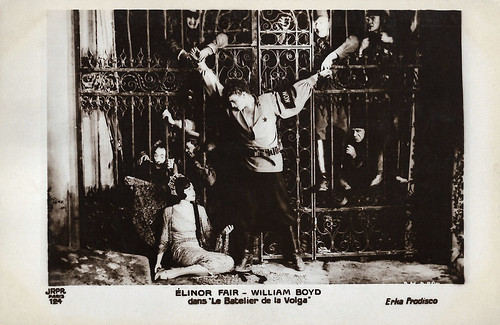
French postcard by JRPR, Paris, no. 124. Photo: Erka Prodisco. Elinor Fair and William Boyd in The Volga Boatman (Cecil B. DeMille, 1926).
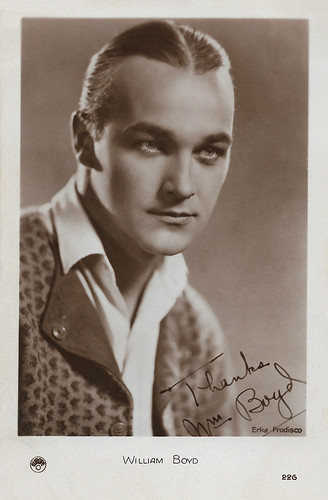
French postcard by Europe. no. 226. Photo: Erka Prodisco.

German postcard by Ross Verlag, no. 3934/1, 1928-1929. Photo: United Artists. William Boyd in Lady of the Pavements (D.W. Griffith, 1929).
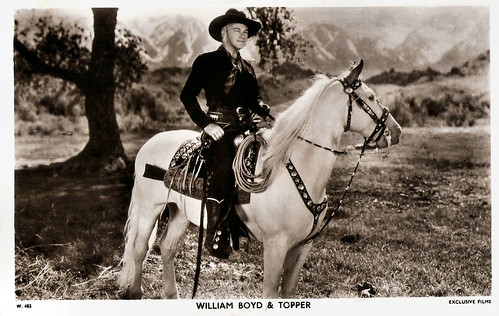
British postcard in the Picturegoer Series, London, no. W.485. Photo: Exclusive Films. Caption: William Boyd & Topper.
Easy charm, charisma, and intense good-looks
William Boyd was born in 1895 in Hendrysburg, Ohio, and reared in Cambridge, Ohio, and lived in Tulsa from 1909 to 1913. He was the son of a day laborer, Charles William Boyd, and his wife, the former Lida Wilkens (aka Lyda). Following his father's death, he moved to California and worked as an orange picker, surveyor, tool dresser, and auto salesman.
During World War I, he enlisted in the army but was exempt from military service because of a "weak heart". In 1918, Boyd arrived in Hollywood and found work as an extra in Why Change Your Wife? (Cecil B. De Mille, 1920) and other films. He saved Cecil B. DeMille's then-favorite actress Julia Faye an awkward situation during the shooting of Saturday Night (1922) when her bathing suit suddenly sprang open. Thanks to this, DeMille would give Boyd his chance a few years after.
Boyd had his definite breakthrough as Jack Moreland in The Road to Yesterday (Cecil B. DeMille, 1925), also with Joseph Schildkraut, Jetta Goudal, and Vera Reynolds. Critics praised Boyd's performance - as the virile minister Jack who doesn't mind kissing flapper Bess (Vera Reynolds) and knows to use his fists when necessary - while moviegoers loved his easy charm, charisma, and intense good-looks.
Due to his growing popularity, DeMille soon cast Boyd as the male lead in the highly successful silent drama, The Volga Boatman (1926). In Tsarist Russia, the Volga boatman Feodor (Boyd) meets Prince Dimitri (Victor Varconi) and his fiancée Vera (Elinor Fair). During the October Revolution, he meets Vera again when he has become a Red Army officer. He receives the order to shoot her but is impressed with her bravery and saves her. Both flee but then have to face the power of Dimitri.
After this film, Boyd had definitely become a matinee idol. He began earning an annual salary of $100,000. He acted in DeMille's extravaganza The King of Kings (Cecil B. DeMille, 1927) in which he played Simon of Cyrene, helping Jesus carry the cross, and DeMille's Skyscraper (Cecil B. DeMille, 1928). He then appeared in D.W. Griffith's Lady of the Pavements (1929) opposite Lupe Velez and Jetta Goudal. Griffith reshot the film to include a couple of musical numbers, making it a part-talkie.

French postcard by JRPR, Paris, no. 123. Photo: Erka Prodisco. William Boyd in The Volga Boatman (Cecil B. DeMille, 1926). This image is a pictorial citation of the famous painting 'Volga Boatmen/ Barge Haulers on the Volga' (1870-1873) by Ilia Efimovich Repin (1844-1930).

German postcard by Ross Verlag, no. 1721/1, 1927-1928. Photo: Arthur Ziehm, Berlin. William Boyd as Tom Kirby in The Last Frontier (Geoge B. Seitz, 1926).

American Arcade card by Ex. Sup Co., Chicago. Photo: Metropolitan. William Boyd as Tom Kirby in The Last Frontier (Geoge B. Seitz, 1926).

German postcard. Ross Verlag, no. 86/11. Photo: National Film. H.B. Warner in the American silent epic The King of Kings (Cecil B. DeMille, 1927). Caption: Jesus on the way to Golgotha. The man helping to carry the cross could be William Boyd, who played Simon of Cyrene.
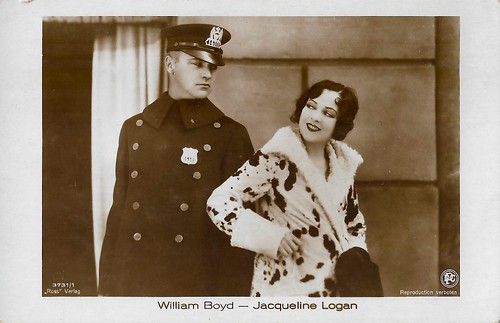
German postcard by Ross Verlag, no. 3731/1. Photo: DPG. Jacqueline Logan and William Boyd in The Cop (Donald Crisp, 1928).
A wholesome, chaste cowboy and a confirmed bachelor
At the beginning of the 1930s, William Boyd's career got a kink, as a newspaper article about the arrest of another actor, William "Stage" Boyd, on gambling and liquor charges were attributed to him. Despite the fact the culprit was just an actor with the same name, Boyd's contract with Radio Pictures was annulled and Boyd was virtually broke and without a job, and for years he had to survive.
His rescue came with the Western Hop-Along Cassidy (Howard Bretherton, 1935). It features the character Hop-Along Cassidy (named because of a limp caused by an earlier bullet wound) of pulp-writer Clarence E. Mulford's 'Bar 20' stories. Boyd was originally offered the role of Buck Peters, the ranch foreman, and Cassidy's old friend, but he decided to ask for the role of Hop-Along instead. Boyd regained his lost fame playing the prematurely gray, black-clad hero, with young Paramount contract player James Ellison as handsome sidekick Johnny Nelson and Charles Middleton as Buck Peters. Hopalong Cassidy's white horse was named 'Topper'.
The character Hopalong Cassidy accompanied him henceforth in his future career. 66 Hopalong Cassidy films were produced between 1935 and 1948, all starring William Boyd in the title role. The series was wildly popular, and all recouped at least double their production costs. Producer Harry Sherman left Paramount in 1942 in favour of United Artists where the "Hopalong" series continued to flourish until 1948. Boyd then bought the rights to the films and re-edited them for television. The 1949-1951 Hopalong Cassidy series was so popular that Boyd filmed 52 new half-hour episodes for the 1952-1954 seasons. Instead of the hard-drinking, rough character from the pulp magazines on which his character was based, Boyd's film character was a wholesome, chaste cowboy - a confirmed bachelor, quite unlike Boyd's own five marriages.
After 70 films, William Boyd recognised early on the possibilities of television and switched to the small screen, where from 1952 onwards he did fifty-two half-hour episodes after he had already shown from 1949 on NBC all of his 66 Hopalong Cassidy films. As he had bought the rights of these films (almost ruining him), he became a wealthy man. He marketed all sorts of "Hoppy" products (lunch boxes, toy guns, cowboy hats, etc.) and received royalties from comic books, radio, and records. In addition, he marketed the character in the circus, variety, and on promotional tours. In the November 27, 1950 issue, Boyd was put on Time magazine's front page and got a star on the Hollywood Walk of Fame.
He retired to Palm Desert, California, in 1953. In 1968 he had surgery to remove a tumor from a lymph gland and from then on refused all interview and photograph requests. In 1972, Boyd died from complications related to Parkinson's disease and congestive heart failure. He was 77. In 1995, he was immortalised in the Western Performers Hall of Fame at the National Cowboy & Western Heritage Museum in Oklahoma City. There is also a Hopalong Cassidy Museum in Cambridge, Ohio. Boyd was married five times, first to a wealthy heiress, Laura Maynard, then to the actresses Ruth Miller, Elinor Fair, Dorothy Sebastian, and Grace Bradley. His only child, a son by second wife Ruth Miller, died in infancy.

Belgian postcard. Photo Artistes Associés (United Artists). S.A. Cacao et Chocolat Kivou, Vilvoorde / N.V. Cacao en Chocolade Kivou, Vilvoorde. William Boyd in Lady of the Pavements (D.W. Griffith, 1929).

German postcard by Ross Verlag, no. 2087/1, 1927-1928. Photo: United Artists.
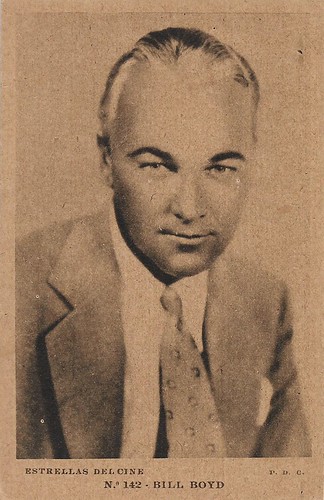
Spanish postcard in the Estrellas del cine by Editorial Grafica, Barcelona, no. 142. Photo: P.D.C. (Producers Distributing Corporation), a company that existed between 1924 and 1927.

Belgian postcard by Ed. journal 'Cinema', Antwerp.

German postcard by Ross Verlag, no. A 1653/1, 1937-1938. Photo: Paramount.
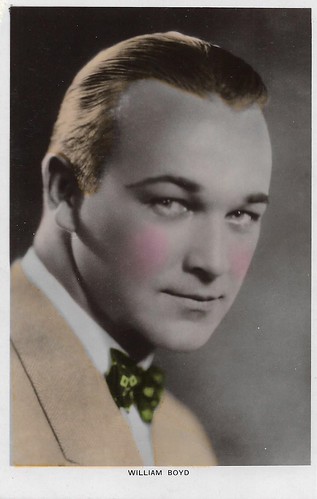
British postcard in the Colourgraph Series, London.

British postcard in the Autograph Series, London, no A 4.

Big British card in the Picturegoer's Gallery, London. Photo: Paramount.
Sources: Hans J. Wollstein (AllMovie), Ed Stephan (IMDb), Wikipedia (English and German), and IMDb.
No comments:
Post a Comment